AUDI TT COUPE 2009 Owners Manual
Manufacturer: AUDI, Model Year: 2009, Model line: TT COUPE, Model: AUDI TT COUPE 2009Pages: 316, PDF Size: 71.16 MB
Page 231 of 316

_____________________________________________ C_h_ e_ c _ k_in -= g_a _ n_d _ f_il _li _n ..;::g =--____.""
When instal ling the battery, make sure the ignition and all electrica l
consumers are switched off~
0.
We recommend that you use maintenance -free or c yc le-re sis
tant/leak -proof
batteries according to the standards TL 825 06 (from
December 1997) and VW 7 50 73 (from August 2001 ) .
Rep lacing the battery should be carried by a qualified workshop .
Please follow the instruct ions on the battery cover.
0 Note
• All work on the battery requ ires technical knowledge . Please
contact an Audi dealership or another authorized facility for ques
t ions about the battery -dange r of acid burns and explosion hazard!
• T he battery must not be opened! Do not try to change the
battery 's liquid level, otherwise detona ting gas will escape from the
battery -explosion hazard I
• The AGM battery in the luggage compartmen t cannot lea k,
because the electrolyte for this battery is absorbed into a special
glass mat. Th is leak -proof battery must not be replace with a
conventional battery .
• Make sure the ventilation hose on the side of the battery is
connected, otherwise fumes or battery acid can leak out.
• Battery holder and term inals a lways have to be secured correctly.
• Before all work on the battery follow the
warnings below ~ & in
"Wor king on the battery" on
page 229 .
ci' For the sake of the environment
Because of the proble m of proper d isposal of a battery, we recom
mend your authorized Audi dealer change the battery for you.
Batteries contain sul furic acid and lead and m ust always be
disposed of properly in compliance with all environmenta l regula
t ions. Disposing of vehic le batteries improperly is ve ry dangerous to
the environment . Make sure that the removed battery cannot over
balance, otherwise su lfur ic ac id might escape!
[ i ] Tip s
If your vehic le is left standing for severa l weeks at extreme ly low
temperatures, the vehicle battery should be removed and stored
where it will not freeze. Th is will prevent it from being damaged and
having to be replaced .•
Working on the battery
Be especially ca ref ul when w orking on o r near the
battery!
F ig . 144 Luggag e
co mp artment :
AGM
battery
T h e ba ttery is loca ted in t he lug gage compartmen t.
Swing up the luggage compartment floor .
Remove the cover plate by t urning the thumb wheel.
The positive ( +l battery termina l is protected by a plastic cover. This
cover must be removed to access the posit ive ( +l terminal when
connecting jumper cab les to start the engine.
Always heed the
safety warning s, when working on the vehicle
battery or the vehicle e lectrica l system to prevent injury.
Vehic le care I I irechnical data
Page 232 of 316
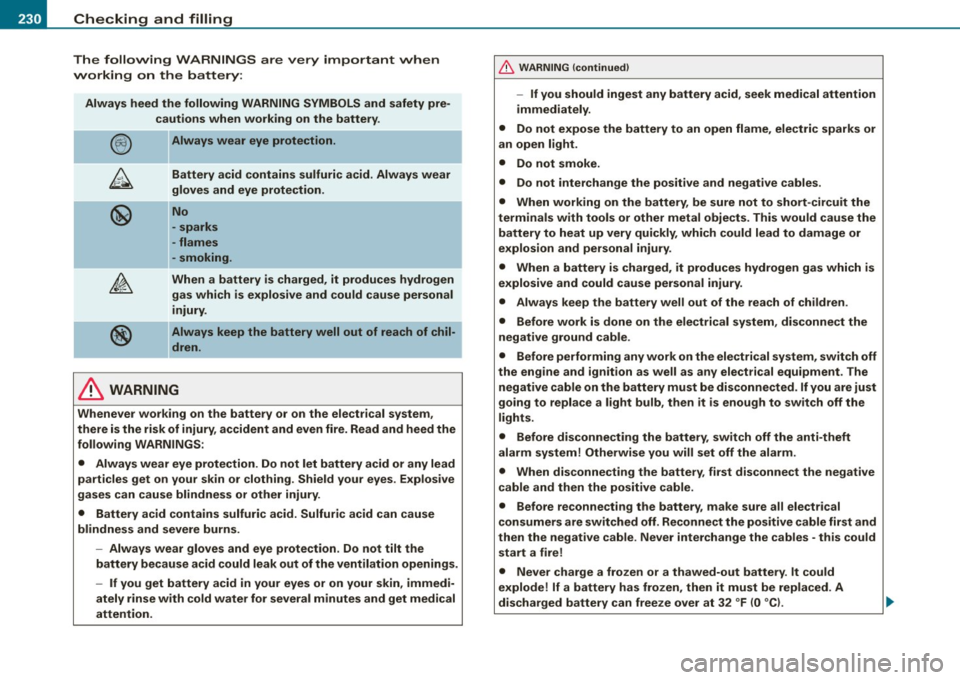
-L~C~ h~ e~c ~k ~in ~ g~a~ n~d !._~ fi~ll ~in ~ g~ ------------------------------------------
The following WARNINGS are very important when
working on the battery:
Always heed the following WARNING SYMBOLS and safety pre
cautions when work ing on the battery .
@
®
Always wear eye protection .
Battery acid contains sulfuric acid. Always wear
gloves and eye protection .
No
· sparks
- flames
· smoking .
When a battery is charged , it produces hydrogen
gas which is explosive and could cause personal
injury .
Always keep the battery well out of reach of chil
dren .
& WARNING
Whenever working on the battery or on the electrical system,
there is the risk of injury , accident and even fire. Read and heed the
following
WARNINGS :
• Always wear eye protection. Do not let battery acid or any lead
particles get on your skin or clothing . Shield your eyes . Explosive
gases can cause blindness or other injury.
• Battery acid contains sulfuric acid. Sulfuric acid can cause
blindness and severe burns.
-Always wear gloves and eye protection . Do not tilt the
battery because acid could leak out of the ventilation openings .
- If you get battery acid in your eyes or on your skin, immedi
ately rinse with cold water for several minutes and get medi cal
attention .
& WARNING (continued)
- If you should ingest any battery acid , seek medical attention
immed iately.
• Do not expose the battery to an open flame , electric sparks or
an open light.
• Do not smoke.
• Do not interchange the positive and negative cables.
• When working on the battery, be sure not to short -circuit the
terminals with tools or other metal objects. This would cause the
battery to heat up very quickly , which could lead to damage or
explosion and personal injury.
• When a battery is charged , it produces hydrogen gas which is
explosive and could cause personal injury.
• Always keep the battery well out of the reach of children .
• Before work is done on the electrical system, disconnect the
negative ground cable .
• Before performing any work on the electrical system , switch off
the engine and ignit ion as well as any electri cal equipment . The
negative cable on the battery must be disconnected . If you are just
going to replace a light bulb , then it is enough to switch off the
lights.
• Before disconnecting the battery , switch off the anti-theft
alarm system! Otherwise you will set off the alarm.
• When disconnecting the battery, first disconnect the negative
cable and then the positive cable.
• Before reconnecting the battery , make sure all electrical
consumers are switched off. Reconnect the positive cable first and
then the negative cable . Never interchange the cables • this could
start a fire!
• Never charge a frozen or a thawed-out battery . It could
explode! If a battery has frozen , then it must be replaced. A
discharged battery can freeze over at 32 °F (0 °Cl. ..,_
Page 233 of 316

Checking and filling -
---------------------=----"=---------
& WARNING ! continued )
• Make sure th e vent hose is always attached to the op ening on
t he side of the battery .
• Never u se batteries which are damaged . Danger of e xplo sion !
Al way s r epla ce a damaged battery .
& WARNING
Californi a Proposition 65 Warning :
• Batt ery po sts, terminal s and related a ccess orie s contain lead
and lead compound s, chemic als kno wn to the St ate of Cal if o rni a
to cau se c ancer and reproductiv e prob lem s. Wash hand s aft er
ha ndl ing .
0 Note
• Do not disconnect the vehicle battery when the ignition is
switched on or when the engine is running, otherwise, you wi ll
damage electronic components in the electrical system .
• If your vehicle is going to stand for a long period of time without
being driven, protect the battery from "freezing", otherwise it wil l
be damaged and will then have to be rep laced. •
Checking the battery acid level on magic eye
batteries*
The battery acid level in the battery can be checked
through the clear inspection window.
_.
Fig . 14 5 Lugg age
co mpa rtmen t: B att ery
w ith m agic eye .
On top of the battery, there is a round "window". This
window (magic eye) c hanges color as the batte ry charge
and acid leve l change .
Read and heed a ll WARNINGS~
& in "Work ing on the
battery" on
page 229
Read the ac id level f rom t he window on the battery
~ fig. 145 .
Air bubbles in the window can cause an inaccurate reading. Care
fully tap on the side of the window.
• I f the window is
green , the battery acid level is correct .
• If t he window has
no color or is bright yellow , the battery acid
level is too low. Have the battery tested by your authorized Audi
dea ler or a qual ified workshop .
• If the window is
bla ck , then the battery is insufficiently charged.
Recharge the battery as soon as possible =>
page 232 . ~
Vehic le care I I irechnical data
Page 234 of 316

-Checking
and filling
---=---------------
0 Note
Do not overfill the battery, otherwise battery acid will overflow
through the vent opening. This can damage the paint and cause
corrosion. •
Checking the battery acid level on
conventional batteries *
The acid level of a conventional battery can be checked
visually.
"' ,...
9
i
Fig . 146 Battery: Elec
trolyte level
- Check the electrolyte level on the front of the battery. The
level should be between the "MIN" and "MAX" mark ings.
If the electrolyte level is below the "MIN" level, have an authorized
workshop fill the battery cell with
distilled water .•
Charging of battery
Starting the engine requires a well charged battery.
Always read and heed all WARNINGS below ~ & and
~ & in "Working on the battery" on page 229.
- Switch off the ignition and all electrical consumers. - Make sure the area is well ventilated when you charge
the battery.
- Connect charger cables.
ALWAYS connect charger cables
POSITIVE
G) to POSITIVE G) ; NEGATIVE Q to NEGATIVE
Q.
- Switch on the charger.
- Make sure the charging rate is not over 6 amps.
- Turn off the charger~&, .
- Disconnect the charger cables.
- Connect both battery cables to the battery if necessary -
first plus, then minus.
It is not ne cessary to remov e th e battery from th e luggage compart
ment, and it is also not necessary to disconnect the cables.
Normally, a battery should be charged at no more than 10 percent
of its ra ted capacity.
For example, a charging current of 4.5 amps would be used on a
battery rated at 45 Ah . Rated capac ity of the battery in your vehicle
is listed on the battery housing.
The ba ttery caps should
not be opened when cha rging a battery.
& WARNING
Charging a battery can be dangerous.
• Never charge a frozen battery. It may explode because of gas
trapped in the ice. Allow a frozen battery to thaw out first.
• Do not reuse batteries which were frozen. The battery housing
may have cracked and weakened when the battery froze.
• Charge the battery in a well ventilated area. Keep away from
open flame or electrical spark. Do not smoke. Hydrogen gas gener-
ated by the battery is explosive. ..,
Page 235 of 316

Checking and filling -
------------- --------=----" =---------
& WARNING !continued )
• To reduce the danger of explosio n, never connect or di sconnect
c h arger cable s whi le the charger i s operating .
• Fast charging a battery i s dang erou s and should only be
atte mpt ed by a competent techni cian with the proper equipment .
• Battery acid that may spill during charging should be washed
off with a solut ion of w arm wat er and bak ing soda to ne utrali ze
the acid .
0 Note
Never use a fast charger as a boos ter to start the engine . This wil l
seriously damage sensitive electronic components, such as control
units, re lays, radio, etc ., as well as the battery charger .
[ i ] Tips
The vehicle battery must not be charged with a standard small
charger that plugs into the cigarette lighter or out let .•
Windshield /headlight washer
conta iner
Fi g. 14 7 Fend er, left:
Wind shi eld washer
flui d re ser voir
T h e w asher fluid container is mark ed wit h the symbol O on
its cap.
Before you c heck anything in the e ngine compartment,
always read and heed all WARNINGS~ & in "Workin g
in t he engi ne compartment" on
page 217.
Lift the fi ller cap to ngue to add washe r fluid . You can fill
t h e container to the top.
Press the cap bac k on to the fi ller neck after fi lling the
container .
You can find the reservoir ca pac ity in the tab le in => page 291.
To prevent lime residue fr om bui lding up on the spray jets, use
dis tilled water when refilling . Always add a g lass cleaner solut ion
(with frost pro tection in the winter).
0 Note
Do not mix eng ine coolant antifreeze or any other additives to fil l up
the windshield washer reservo ir. •
Vehic le care I I Technical data
Page 236 of 316
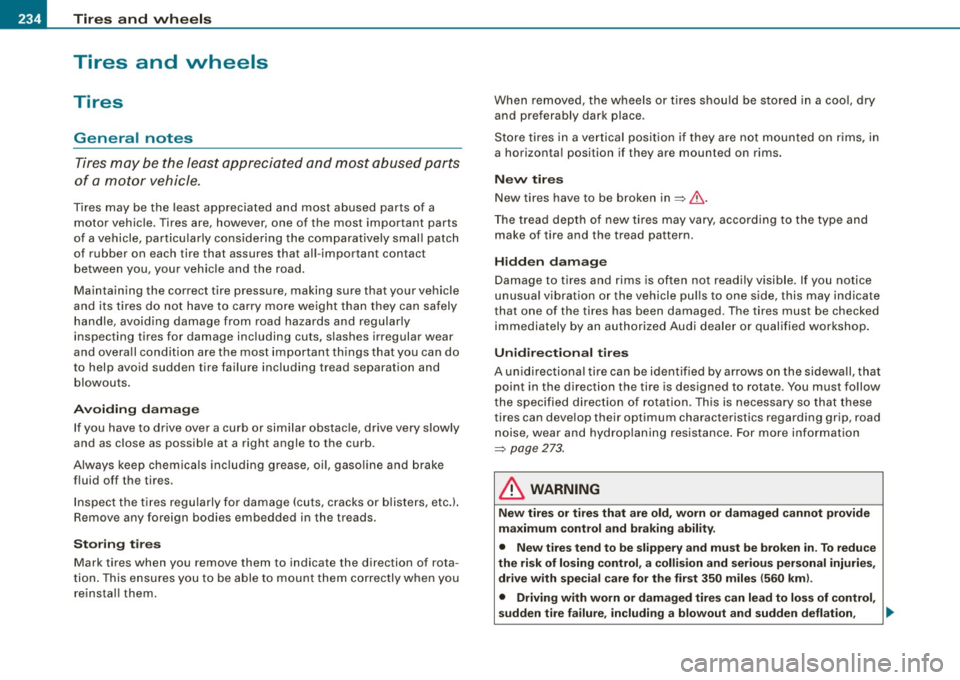
-~_T_ ir_e_ s_ a_ n_d _ w_ h_ e_e _l_s _________________________________________________ _
Tires and wheels
Tires
General notes
Tires may be the least appreciated and most abused parts
of a motor vehicle.
Tires may be the least appreciated and most abused parts of a
motor vehicle. Tires are, however, one of the most important parts
of a vehicle, particu larly considering the comparatively small patch
of rubber on each tire that assures that all -important contact
between you, your vehic le and the road.
Maintaining the correct tire pressure, making sure that your vehicle
and its tires do not have to carry more weight than they can safely
handle, avoiding damage from road hazards and regularly inspecting tires for damage inc luding cuts, s lashes irregular wear
and overa ll condition are the most important things that you can do
to help avoid sudden tire failure including tread separation and
blowouts.
A vo iding d am age
If you have to drive over a curb or similar obstac le, drive very slowly
and as close as possible at a right angle to the curb.
A lways keep chemica ls including grease, oi l, gaso line and brake
fluid off the tires.
Inspect the ti res regu larly for damage (cuts, cracks or b listers, etc.l .
Remove any foreign bodies embedded in the treads.
Storing tir es
Mark tires when you remove them to indicate the direction of rota
t ion. This ensures you to be able to mount them correctly when you
reinstal l them. When removed, the wheels or tires shou
ld be stored in a coo l, dry
and preferably dark place.
S tore tires in a vertical pos it ion if they a re not mounted on r ims, in
a horizonta l position if they are mounted on rims.
New tir es
New tires have to be broken in=>&.
The tread depth of new ti res may vary, according to the type and
make of tire and the tread pattern.
H idd en damage
Damage to tires and rims is often not readily visible. If you notice
unusual vibration or the vehicle pu lls to one s ide, this may indicate
that one of the tires has been damaged . The tires must be checked
immediately by an authorized Audi dealer or qualified workshop .
Unidire cti ona l t ires
A unidirectional tire can be identif ied by arrows on the sidewa ll, that
point in the direction the tire is designed to rotate . You must fo llow
t he specified directio n of rotation . This is necessary s o that these
tires can develop their optimum characteristics regarding grip, road noise, wear and hydrop laning resistance . For more information
=>
page 273.
& WARNING
New t ires o r ti re s th at a re old , worn or d am aged cann ot pro vid e
maximum cont rol and braking ability .
• New tires te nd to be slippery and mu st be bro ken in . To redu ce
the ri sk o f lo sin g co ntro l, a collis ion and serious per sonal injurie s,
dri ve w ith special care f or the fi rst 350 m ile s ( 560 km l.
• Driving w ith w orn or damaged tire s can lead to lo ss of control ,
sudd en tir e fa ilure , inc ludi ng a blowout a nd sudden defl atio n, ..,_
Page 237 of 316
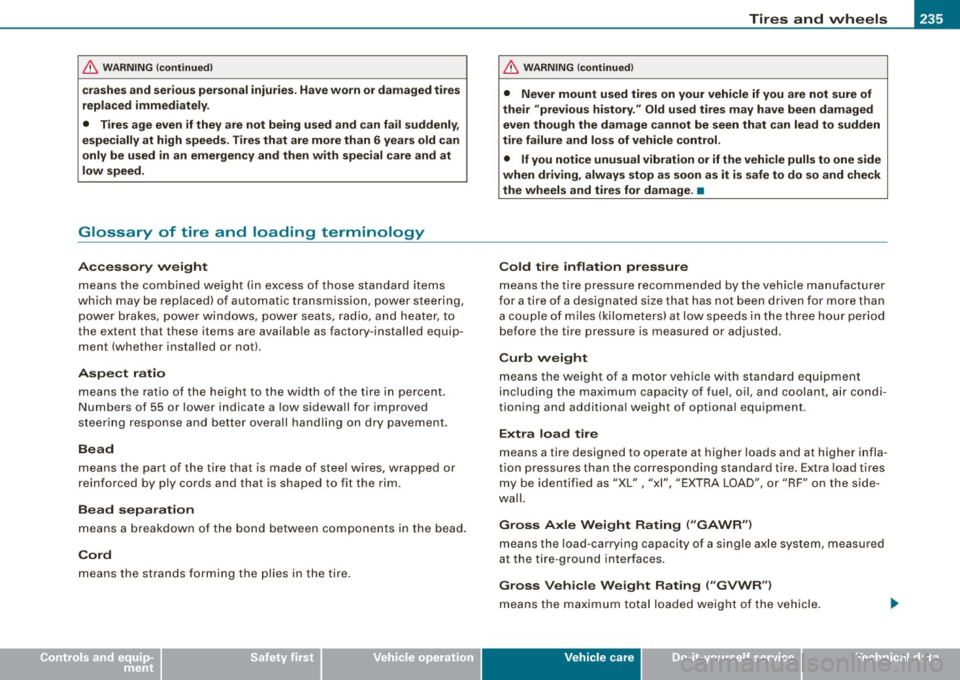
Tires and wheels -
----------------
•
& WARNING (continu ed )
crashes and serious personal in jur ies . Have worn or da maged t ires
replaced immediately .
• Tires age even if they are not being u sed and can fail suddenly ,
especially at high speeds. T ires that are more than 6 years old can
only be used in an emergency and then w ith special care and at
low speed.
Glossary of tire and loading terminology
Accessory weight
means the co mbined we ig ht ( in excess o f those sta nda rd items
which may be rep laced) of automatic transmission, power steering,
power brakes, power w indows, powe r seats, rad io, a nd heater, to
the extent that these items are avai lab le as factory-installed equip
m ent (w hether insta lled or not).
Aspect ratio
means t he ratio o f th e height to t he w idt h of the tire in perce nt.
N umbers of 55 or lower indicate a low sidewa ll for improved
steer ing respo nse and b ette r overall ha ndl ing on dry pave ment.
Bead
means the part of the tire that is made of stee l wires, wrapped or
reinforced by ply cords and that is shaped to fit the rim.
Bead separation
means a breakdow n of the bond be tween co mponents i n the bead.
Cord
means the strands fo rmi ng the plies in the ti re.
& W ARNING (continued )
• Never mount used tires on your vehicle if you are not sure of
their "previous history. " Old used t ire s may ha ve been damaged
even though the damage cannot be seen that can lead to sudden
tire failure and lo ss of vehicle control.
• If you noti ce unusual vibration or if the vehicle pulls to one side
when driving , always stop as soon as it is safe to do so and check
the wheels and tires for damage . •
Cold tire inflation pressure
mea ns t he ti re pressure reco mm ended by the ve hicle ma nufacturer
for a tire of a designated size that has not been d riven for more tha n
a cou ple o f miles (k ilometers) at low speeds in t he t hre e ho ur per iod
before the tire pressure is measured or ad justed .
Curb weight
means the weight of a moto r vehic le with standard equipment
i nc lud ing the max imu m capac ity o f fue l, o il, and coola nt, a ir c ond i
tioning and additiona l weight of optional equipment.
Extra load tire
means a tire designed to ope rate at higher loads and at higher infla
tion pressures than the corresponding standard tire. Extra load tires
my be identified as "XL",
"xi", "EX TRA LOAD", or "RF" on the side
wa ll.
Gross Axle Weight Rating ("GAWR ")
means the load -carrying capacity of a sing le ax le system, measured
at the ti re -ground interfaces.
Gross Vehicle Weight Rating ("GVWR "l
means the ma ximum tot al l oade d weigh t of the vehicle.
Vehicle care I t •
Page 238 of 316
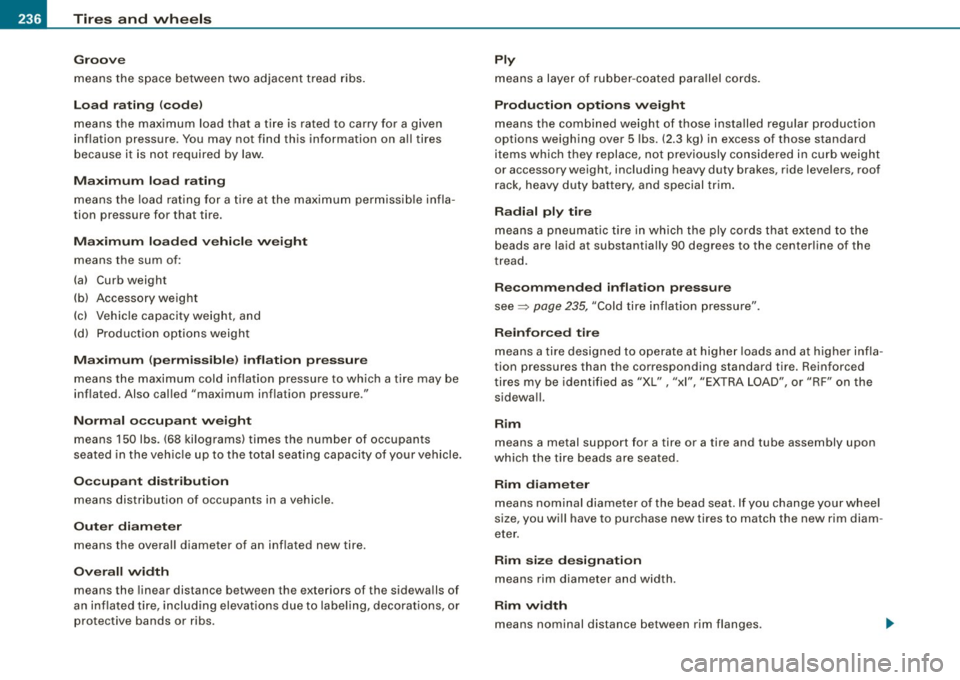
-~_T_ ir_e_ s_ a_ n_d _ w_ h_ e_e _l_s _________________________________________________ _
Groove
means the space between two adjacent tread ribs.
Load rating (code)
means the maximum load that a tire is rated to carry for a given
inflation pressure . You may not find this information on all tires
because it is not required by law.
Maximum load rating
means the load rating for a tire at the maximum permissible infla
tion pressure for that tire.
Maximum loaded vehicle weight
means the sum of:
(a) Curb weight
(b) Accessory weight
(c) Vehicle capacity weight, and
(d) Production options weight
Maximum (permissible) inflation pressure
means the maximum cold inflation pressure to which a tire may be
in flated. Also called "maximum inflation pressure ."
Normal occupant weight
means 150 lbs. (68 kilograms) times the number of occupants
seated in the vehicle up to the total seating capacity of your vehicle.
Occupant distribution
means distribution of occupants in a vehicle .
Outer diameter
means the overall diameter of an inflated new tire.
Overall width
means the linear distance between the exteriors of the sidewalls of
an inflated tire, including elevations due to labeling, decorations, or
protective bands or ribs .
Ply
means a layer of rubber -coated parallel cords.
Production options weight
means the combined weight of those installed regular production
options weighing over 5 lbs. (2.3 kg) in excess of those standard
items which they replace, not previously considered in curb weight
or accessory weight, including heavy duty brakes, ride levelers, roof rack, heavy duty battery, and special trim.
Radial ply tire
means a pneumatic tire in which the ply cords that extend to the
beads are laid at substantially 90 degrees to the centerline of the
tread.
Recommended inflation pressure
see =:> page 235, "Cold tire inflation pressure".
Reinforced tire
means a tire designed to operate at higher loads and at higher infla
tion pressures than the corresponding standard tire. Reinforced
tires my be identified as "XL", "xi", "EXTRA LOAD", or "RF" on the
sidewall.
Rim
means a metal support for a tire or a tire and tube assembly upon
which the tire beads are seated .
Rim diameter
means nominal diameter of the bead seat. If you change your wheel
size, you will have to purchase new tires to match the new rim diam
eter.
Rim size designation
means rim diameter and width.
Rim width
means nominal distance between rim flanges .
Page 239 of 316
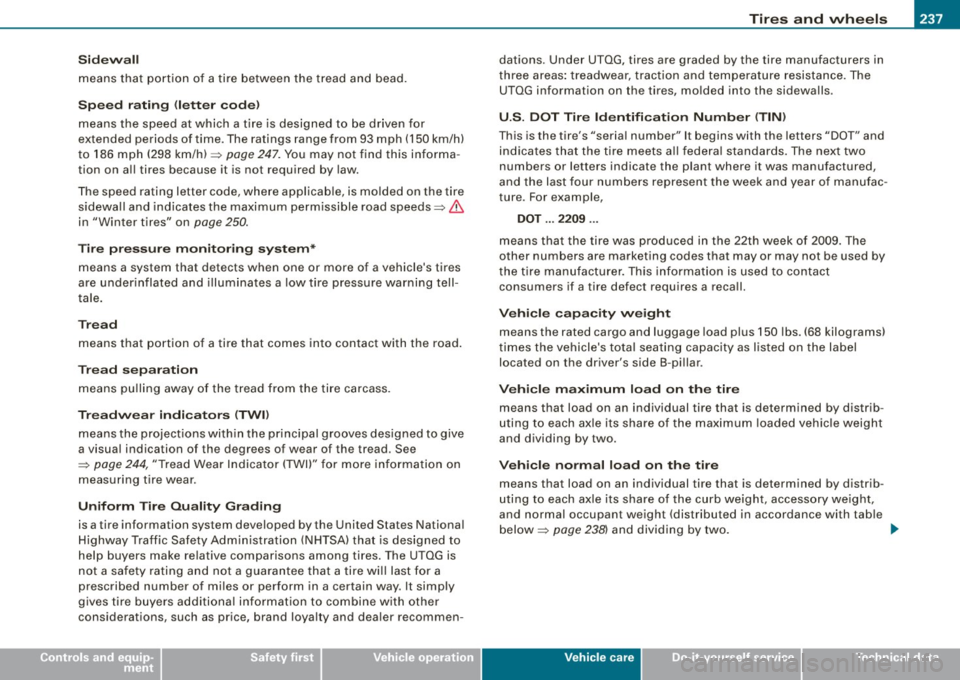
________________________________________________ T_ i _r_e _s_ a_n_ d_ w_ h_ e_e _ l_s __ fflllll
•
S idewa ll
means that portion of a tire between the tread and bead.
Speed ra ting
extended periods of time. The ratings range from 93 mph (150 km/h)
t o 186 mph (298 km/h) =>
page 247. You may not find this informa
tion on all tires because it is not required by law.
The speed rating letter code, where applicab le, is molded on the tire
sidewa ll and indicates the maximum perm issible road speeds=>
&
in "Winter tires" on page 250.
T ire pre ssu re m onit orin g sys te m *
means a system that detects when one or more of a vehicle's tires
are under inflated and illuminates a low tire pressure warning tell
tale.
Tre ad
means that portion of a tire that comes into contact with the road .
Tread sepa ra ti on
means pu lling away of the tread from the tire carcass.
Tr ea dw ear indi cato rs ( TW I)
means the projections with in the principal grooves designed to give
a visual indication of the degrees of wear of the tread . See
~ page 244, "Tread Wear Indicator (TWI)" for more information on
measuring tire wear.
U ni form Tire Q ua lity G radin g
is a tire information system developed by the United States National
Highway Traffic Safety Administration (N HTSA) that is designed to
help buyers make re lative comparisons among tires. The UTQG is
not a safety rating and not a guarantee that a tire will last for a
prescribed number of miles or perform in a certain way. It simply
gives tire buyers additiona l information to combine with other
considerations, such as price, brand loya lty and dealer recommen- dations
. Under UTQG, tires are graded by the tire manufacturers in
three areas : treadwear, trac tion and temperature resistance. The
U TQG information on the tires, molded into the sidewalls.
U .S . DOT Tire Identifi cation Number (TIN )
This is the tire's "serial number" It begins with the letters "DOT" and
indicates that the ti re meets a ll federa l standards. The next two
numbers or letters indicate the plant where it was manufactured,
and the last four numbers represent the week a nd year of manufac
ture . For example,
DOT ... 2209 ...
means that the tire was produced in the 22t h week of 2009. The
other numbers are marketing codes that may or may not be used by
t he tire manufacturer. This information is used to contact
consumers if a tire defect requires a recall.
Vehi cle cap acity we ight
means the rated cargo and luggage load plus 150 lbs. (68 kilograms)
times the vehicle's tota l seating capacity as l is ted on the label
located on the driver's side B -pi llar.
V eh icle maximum load on the tire
means that load on an individual tire that is determined by distrib
uting to each ax le its share of the max imum loaded vehicle weight
and dividing by two.
Ve hic le normal lo ad on the tire
means that load on an individual tire that is determined by distrib
uting to each ax le its share of the curb weight, accessory we ight,
and normal occupant weight (distributed in accordance with tab le
below =>
page 238) and dividing by two . ._
Vehicle care I t •
Page 240 of 316
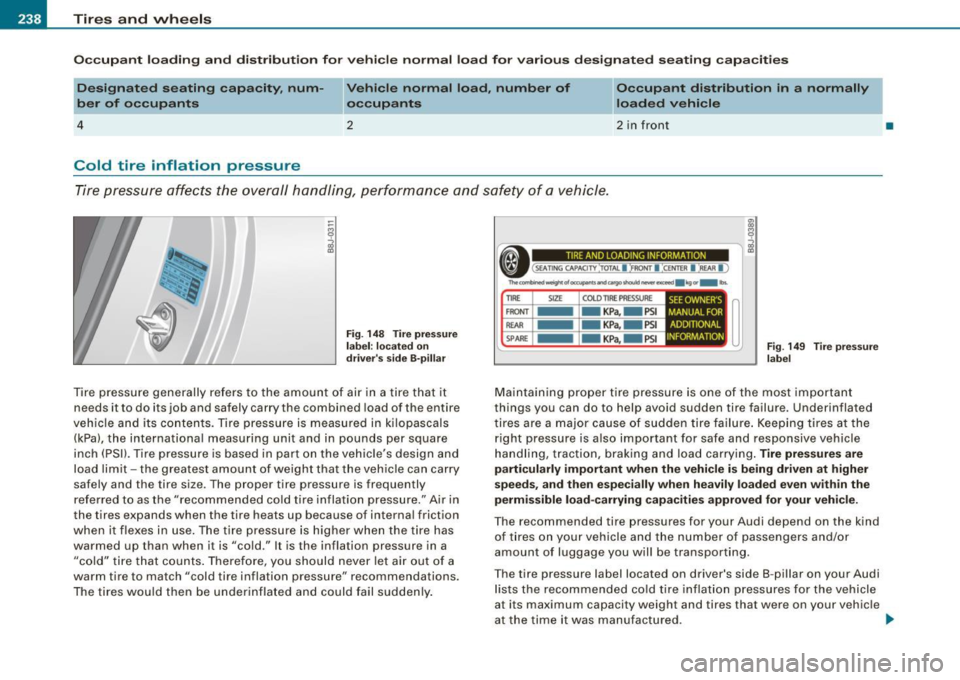
___ T_ i_ r_e _s_ a_ n_ d_ w_ h_ e_ e _ ls _________________________________________________ _
Occupant loading and distribution for vehicle normal load for various designated seating capacities
Designated seating capacity, num
ber of occupants Vehicle normal load, number of
occupants Occupant distribution in a normally
loaded vehicle
4
2 2 in front
Cold tire inflation pressure
Tire pressure affects the overall handling, performance and safety of a vehicle.
Fig. 148 Tire pressure
label: located
on
driver 's side B-pillar
Tire pressure generally refers to the amount of air in a tir e that it
needs it to do its job and safely carry the combined load of the entire
vehicle and its contents. Tire pressure is measured in kilopascals
(kPa), the international measuring unit and in pounds per square
inch (PSI). Tire pressure is based in part on the vehicle's design and
load limit -the greatest amount of weight that the vehicle can carry
safely and the tire size. The proper tire pressure is frequently
referred to as the "recommended cold tire inflation pressure." Air in
the tires expands when the tire heats up because of internal friction
when it flexes in use. The tire pressure is higher when the tire has
warmed up than when it is "cold ." It is the inflation pressure in a
"cold" tire that counts. Therefore, you should never let air out of a
warm tire to match "cold tire inflation pressure" recommendations .
The tires would then be underinflated and could fail suddenly.
* ,. ~ =cc- ------------------gl
( SEATING CAPAOTY '.TOTAl l :FRONT I :CE NTER I '.REAR I )
Toea,m....,_ oroa,.,pan11anda,golhould ,-!IICN
SIZE COLO TIRE PRESSURE
- KPa,- PSI
- KPa,- PSI
- KPa,- PSI MANUAL FOR
ADDITIONAL
INFORMATION SEEOWNER'S I
Fig . 149 Tire pressure
label
Maintaining proper tire pressure is one of the most important
things you can do to help avoid sudden tire failure . Underinflated
tires are a major cause of sudden tire failure. Keeping tires at the
right pressure is also important for safe and responsive vehicle
handling, traction, braking and load carrying .
Tire pressures are
particularly important when the vehicle is being driven at higher
speeds, and then especially when heavily loaded even within the
permissible load -carrying capacities approved for your vehicle.
The recommended tire pressures for your Audi depend on the kind
of tires on your vehicle and the number of passengers and/or
amount of luggage you will be transporting .
Th e tire pressure label located on driver's side 8 -pillar on your Audi
lists the recommended cold tire inflation pressures for the vehicle
at its maximum capacity weight and tires that were on your vehicle
•
at the time it was manufactured . .,